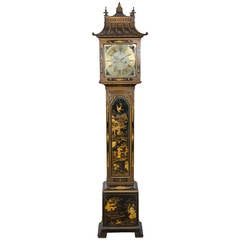Chinese Grandmother Clock
Recent Sales
Antique Early 1900s English Chinese Chippendale Grandfather Clocks and L...
Wood
A Close Look at Chinese-chippendale Furniture
Like chinoiserie, which had emerged in Europe in the 17th century, antique Chinese Chippendale furniture was an appropriation of Asian design that often distilled it to stereotypes.
Thomas Chippendale published The Gentleman and Cabinet-Maker’s Director in 1754, and the widespread popularity of the book of furniture designs influenced a new style of furniture named for the English cabinetmaker. Artisans in England, the United States and Europe adapted the work illustrated in its pages. The publication of the pattern book included designs reflecting “Gothic, Chinese and Modern Taste,” with illustrations of “Chinese” chairs and cabinets featuring elaborate hand-carved latticework.
Pagoda-shaped flourishes and wood painted in the “japanned” finish that mimicked lacquer were common on these pieces, as were fretwork patterns on chair backs. The back of a chair is the easiest way to distinguish between Gothic, Rococo and Chinese Chippendale chairs, all of which typically feature broad seats and luxurious upholstery. Chippendale’s designs for “Chinese” chairs tend to favor more clean lines and less ornamentation than the other styles, with cutouts in the rails and the fretwork on the back evoking a European ideal of East Asian design.
Dark woods such as walnut and solid mahogany were commonly used, as were bamboo turnings. Cabinets for imported Chinese ceramics frequently were adorned with glazing bars, while small tea tables were detailed with angular fretwork. The style remained popular through the 18th century and into the decades that followed, even inspiring an entire room at Buckingham Palace.
Find antique Chinese Chippendale dining room chairs, side tables, case pieces and other furniture and decor on 1stDibs.
Finding the Right Grandfather-clocks-longcase-clocks for You
Antique grandfather clocks and longcase clocks are staples of old-world design sensibilities, and, along with their storied history, these statuesque timepieces can bring a feeling of warmth to living rooms, dining rooms and other areas of your home.
Longcase clocks, which originated in England and were manufactured in the United States beginning in the 1700s, refer to tall clocks with a face and clock works positioned high in the housing while a large swinging pendulum movement is tucked inside the case, which is supported by a carved base called a plinth.
While guests making their way through your foyer (another ideal location for such a furnishing) might typically refer to your longcase clock as a “grandfather clock,” there are actually three varieties of these stylish floor clocks, which include granddaughter clocks (the shortest, generally not one solid piece of wood and around three to five feet tall), grandmother clocks (the slimmer middle ground, between five feet and six feet tall) and grandfather clocks, which are typically between six and seven feet tall.
Sculptural and statement-making, antique grandfather clocks created by the likes of the Seth Thomas Clock Company, the Howard Miller Clock Company, Hermle or other clockmakers are an alluring choice in filling up space in a room, while the shorter longcase clocks are just as useful if you need an element that is comparatively muted or you’re working with limited space.
Each generation of artisan clockmakers, working in various furniture styles over time, contributed its own flourishes to the design of longcase clocks. Antique grandfather clocks in the Georgian style share commonalities with neoclassical design. They were often made in dark woods such as mahogany and feature intricate carving. Mahogany is also common for Victorian-era grandfather clocks, although examples of this style can be found in oak and walnut too. Designers of contemporary grandfather clocks are using a range of materials.
It’s easy to get confused when determining the origins or value of an antique grandfather clock or other vintage longcase clock. While an antique appraiser will be able to tell quickly, searching for a manufacturer’s name engraved on the face and dial of the clock may be an easy way to learn about the history of your clock.
Find a distinctive variety of antique grandfather clocks and longcase clocks on 1stDibs, and browse our collection of unusually beautiful clocks, wall clocks, desk clocks and other vintage clocks too.
- 1stDibs ExpertApril 5, 2022A grandmother clock is one that is shorter than a grandfather clock. It stands less than 6’3” tall and has a slimmer case. As it takes up less space than a grandfather clock, a grandmother clock is a great choice for halls, foyers and smaller rooms. Shop a collection of grandmother clocks from some of the world’s top sellers on 1stDibs.
- 1stDibs ExpertOctober 7, 2024The difference between a grandmother clock and a granddaughter clock is height. A grandmother clock is a longcase clock that is usually around 60 to 72 inches tall, while a granddaughter clock is one that is 36 to 60 inches high. Both are shorter than a grandfather clock, which typically measures 73 to 90 inches in height. Explore a diverse assortment of grandmother and granddaughter clocks on 1stDibs.
- 1stDibs ExpertOctober 24, 2024To tell the age of a grandmother clock, research its maker using trusted online resources. If you're unsure who produced your clock, look on the inside and back for a maker's marking. Many makers dated their grandmother clocks in some fashion. Depending on the maker, there may be a serial number, movement number or date code that you can use to determine your clock's year of production. By learning how to date clocks produced by your piece's manufacturer, you should be able to at least estimate its age. Alternatively, you can have a certified appraiser or knowledgeable antique dealer examine your clock and date it for you. Find a range of grandmother clocks on 1stDibs.
